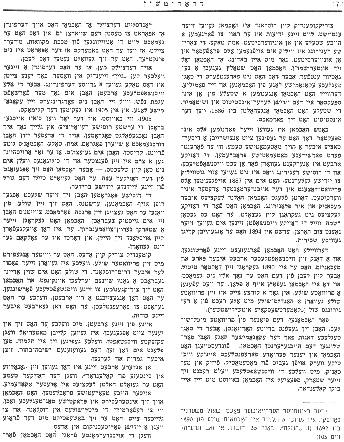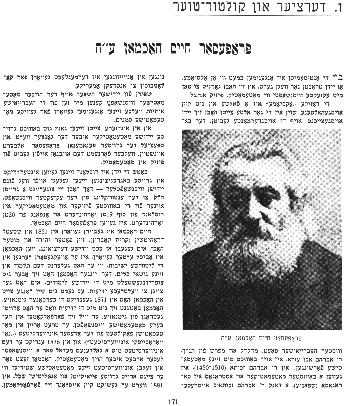
[Page 169; Page 170 blank]

[Page 171]
EDUCATORS AND CULTURAL ACTIVISTS
[Photo:] Professor Chaim Hochman
[Page 172]
Chaim Hochman was very disappointed when he returned to Russia. Based on his achievements, he was suited for a major position in a university. The Czarist government was willing to appoint him professor in a university on condition that he convert to Christianity. He responded resoundingly in the negative, but this didn't solve the day-to-day financial problems of Hochman and his family. In the meantime, he accepted a position as inspector at the Jewish teacher's institute in Zhitomir. He held this position until 1886, when the institute closed.
Although he was very involved in his work as inspector, Hochman found time to write a dissertation on an advance mathematics subject, in which he solved various mathematical problems. His dissertation was recognized as extremely scientific, and in 1887, the Russian government – which wasn't so favorably disposed toward Jewish intellectuals – appointed him as a private instructor at the university in Odessa, where he gave lectures in mechanics and planning. Hochman didn't receive any payment for these lectures, and did it out of his own devotion, because these sciences were very close to his heart. He only started receiving payment in 1894.
Meanwhile, Hochman continued his research, and thanks to his scientific work on steam and mechanics, he was awarded the title of PhD. in 1890. Nevertheless, he still made no money from it, and so he came up with a plan to open his own private school. In a short time his school became trade school entitled to all the rights of a government school.
For Hochman, a pioneer in the field of private middle schools, wide horizons were now open. Nevertheless, he was still confronted with the day-to-day financial problems. Then suddenly at that time Hochman published a few important works on the subjects of mathematics, physics and mechanics, which strongly impressed the scientific community. He became especially well known for his perpetual calendar.
Former residents of Drohitchin recall that Hochman also invented a device to measure the Black Sea; he based it on instructions in the Talmudic tractate of Mikvaot. The story goes that when he noticed that his device was not precise, he wanted to commit suicide. There is also the story that he invented a waterproof watch – in those days this was a tremendous invention. Nevertheless, all of his scientific work created a lot of suffering because they didn't ease his financial situation. The climax was in 1905.
As is known, the year 1905 was when the first Russian revolution took place, and was followed by pogroms. Odessa Jews also experienced a serious pogrom. Hochman's Christian friends advised Hochman to hang a crucifix in his window to spare him the wrath of the hooligans, but Hochman rejected this idea, and preferred sharing the fate of his Jewish brothers.
The Russian pogroms affected Hochman very negatively. First, because his school, which was the source of his livelihood, was closed. Second, the pogroms broke him emotionally, and he suffered a major nervous breakdown. He quickly went abroad, where he recovered completely.
Upon his return to Odessa Hochman continued to run his private school, which was very popular throughout southern Russia. The school provided him with a decent income, and he was able to return to his scientific activities. He wrote a series of treatises that he hoped to publish, but he overworked himself.
One of his projects at that time was to collect material relating to the exact sciences appearing in the Talmud. During this time, he was like his old self as a yeshiva student poring over his Talmudic tractates. Another project was his Analysis and Synthesis of the Calendar. He was supposed to give lectures about this topic at the Odessa Academy. Aside from complicated theoretical problems, Hochman was also interested in practical matters such as reforming Middle Schools in Russia and the question of a Jewish polytechnical school in Odessa.
Previous Page
|
Next Page
JewishGen, Inc. makes no representations regarding the accuracy of
the translation. The reader may wish to refer to the original material
for verification.
JewishGen is not responsible for inaccuracies or omissions in the original work and cannot rewrite or edit the text to correct inaccuracies and/or omissions.
Our mission is to produce a translation of the original work and we cannot verify the accuracy of statements or alter facts cited.
 Drogichin, Belarus
Drogichin, Belarus
 Yizkor Book Project
Yizkor Book Project
 JewishGen Home Page
JewishGen Home Page
Copyright © 1999-2024 by JewishGen, Inc.
Updated 13 Dec 2001 by LA